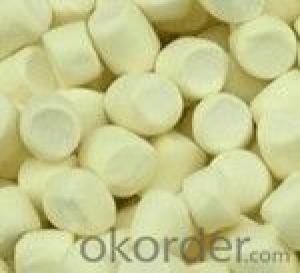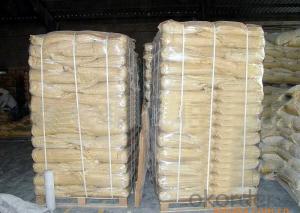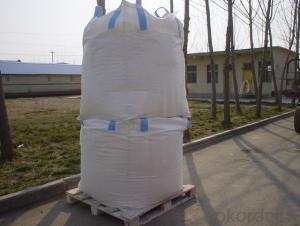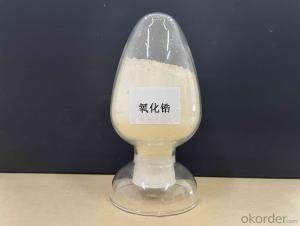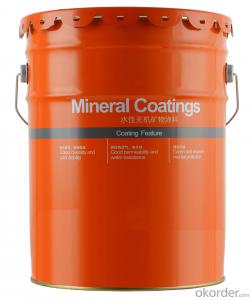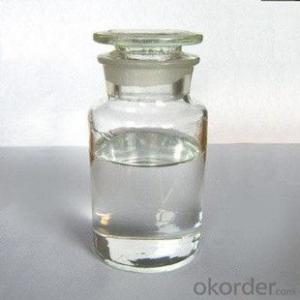Rubber Chemcials Rubber Antioxidant Model TMQ
- Loading Port:
- Tianjin
- Payment Terms:
- TT OR LC
- Min Order Qty:
- 25 m.t.
- Supply Capability:
- 12000 m.t./month
OKorder Service Pledge
OKorder Financial Service
You Might Also Like
RD (TMQ)
Chemical Name:2,2,24-Trimethy 1-1,2- Dihydroquinoline content
Molecular Weight: (173.26)n
CAS No.:26780-96-1
Executive standard: GB/T 8826-2003
Specification:
Item | Index | ||
High Content | High Class Product | First Class Product | |
Appearance | Amber to light brown flake or granular | ||
Softening Point ℃ | 90.0+10.0 | 80~100 | |
Heat Loss % ≤ | 0.30 | 0.30 | 0.50 |
Ash% ≤ | 0.20 | 0.30 | 0.50 |
Assay % ≥ | 77.0 | -- | -- |
Isopropyl-bis aniline % ≤ | 0.20 | -- | -- |
Issolubles in alcohol % ≤ | 0.50 | -- | -- |
Properties: Pale yellow to amber power or thin.Nontoxic Not soluble in water, soluble in benzene.Chloroform,acetone and carbon disulfide,Miro-soluble petroleum hydrocarbons.
Application:The product is particular excellent kinds od eneral-purpose ammonia anti-ageing agent.Ti particular suit to full-stell,semi-steel radial tire and it apply to many kinds of the tires,rubber tube,gummed tape, rubber overshoes and general industrial rubber producers and also suits to emulsion products.
Packing:25kg paper bag inner with PE bag.
Storage:The product should be stored in the fry and colling place with good ventilation. The product should be avoid hot sunshine.
- Q:what is metallocene catalyst technology?
- Metallocene catalyst A transition-metal atom sandwiched between ring structures having a well-defined single catalytic site and well-understood molecular structure used to produce uniform polyolefins with unique structures and physical properties. See also Catalysis; Coordination chemistry; Coordination complexes; Metallocenes; Organometallic compound. In the early 1980s, W. Kaminsky discovered that an appropriate co-catalyst activated metallocene compounds of group 4 metals, that is, titanium, zirconium, and hafnium, for alpha-olefin polymerization, attracting industrial interest. This observation led to the synthesis of a great number of metallocene compounds for the production of polymers already made industrially, such as polyethylene and polypropylene, and new materials. Polymers produced with metallocene catalysts represent a small fraction of the entire polyolefin market, but experts agree that such a fraction will increase rapidly in the future. See also Polymer; Polymerization; Polyolefin resins.
- Q:What is a Catalyst?
- catalyst is used to speed up the reaction but it does not react itself with reactant and remain unchanged
- Q:Also, how is the catalyst affected by heat? Please answer all of the questions not just one of the three. THANK YOU!
- The catalyst is affected by vinegar because vinegar is acidic meaning there are more H+ ions. This alters the charges on the R groups of the amino acid residues of the enzyme molecule. The bonds that help maintain the conformation of the enzyme molecule which is ionic will therefore, be disrupted and the binding of substrate will be affected. However, if pH is restored to optimum pH, the maximum activity of the enzyme will be restored but this is only if the pH was only altered by a small extent. If pH is altered by a large extent, the conformation of the enzyme molecule will be severely affected causing it to denature. The catalyst is affected by heat because excessive heat disrupts the intermolecular bonds which stabilise the secondary and tertiary structure of an enzyme molecule(the enzyme molecule has a tertiary structure). The enzyme molecule unfolds and the precise shape of the active site is lost. This loss of structure and function is irreversible.
- Q:How the catalyst accelerates the chemical reaction
- Add pigments
- Q:Please help me
- enzymes are like chemical scissors that break up starch inside your body they work best at 37'c which is body temperatur i think they are in the stomach? don't know for sure hope this helped as for catalysts i dont know
- Q:What is the chemical vinyl chloride and benzene plus catalyst?
- Looks like no ethyl benzene, it is vinyl benzene
- Q:Please make it simple because I need it for school and please give to examples for the second part Thanx :D
- A catalyst is a substance that speeds up the rate of a chemical reaction with itself being chemically unchanged at the end of the reaction. They are useful as they help to lower the minimum amount of energy needed ( also known as activation energy) to start the reaction. Hence, by lowering the activation energy of the reaction, they help to speed up the rate of reaction. For example, in the Haber process for the manufacture of ammonia, the catalyst iron is added to speed up the rate of reaction between hydrogen gas and nitrogen gas. Otherwise, the reaction would have proceeded much more slowly. Another example is the catalyst nickel used in the manufacture of margarine and vanadium (V) oxide for manufacturing sulfuric acid. As catalyst remain chemically unchanged after a reaction, they can be reused again and hence, they are required in minute amounts. An example is the washing powder used in washing clothes, they help to remove food stains by digesting the proteins in food. They can be reused after each reaction and hence, you do not need to add in the whole packet of washing powder but only a few spoonful.
- Q:High chemistry: Does the catalyst affect the heat and heat of the reaction?
- The catalyst that has no effect affects only the rate of reaction
- Q:describe a biological catalyst?
- A biological catalyst is the almighty enzyme. An enzyme takes the food that animals eat, yes including you, and breaks the raw stuff into more tangible byte sizes pieces for all the cells of a living organism. So essentially a catalysts is a mover of a biological system. Whole systems such as the apex predator the great bald eagle. I think the whole system catalyst are the decomposer organisms. The little crawlers like shredders and mushrooms. I hope that this helps
1. Manufacturer Overview |
|
|---|---|
| Location | |
| Year Established | |
| Annual Output Value | |
| Main Markets | |
| Company Certifications | |
2. Manufacturer Certificates |
|
|---|---|
| a) Certification Name | |
| Range | |
| Reference | |
| Validity Period | |
3. Manufacturer Capability |
|
|---|---|
| a)Trade Capacity | |
| Nearest Port | |
| Export Percentage | |
| No.of Employees in Trade Department | |
| Language Spoken: | |
| b)Factory Information | |
| Factory Size: | |
| No. of Production Lines | |
| Contract Manufacturing | |
| Product Price Range | |
Send your message to us
Rubber Chemcials Rubber Antioxidant Model TMQ
- Loading Port:
- Tianjin
- Payment Terms:
- TT OR LC
- Min Order Qty:
- 25 m.t.
- Supply Capability:
- 12000 m.t./month
OKorder Service Pledge
OKorder Financial Service
Similar products
New products
Hot products
Related keywords
